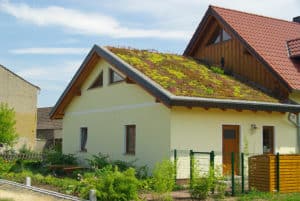-

When many people think of a green roof, they think of the color green or that the roof may be ecologically sound and energy efficient. In reality, all three are true, achieved not by using typical roofing materials but by using a roof as a living garden.
This type of roof is aesthetically pleasing and environmentally sound. In the last two decades, they’ve emerged in major cities across the globe as solutions for water issues, reduced energy consumption and managing city microclimates.
- A green roof is a natural way to manage storm drainage and to some degree water quality. The roof absorbs the majority of the rainfall, and less flows into storm drainage systems. Storm drainage, especially in cities, carries pollutants from vehicles, landscape chemicals, and insecticides. Cities like San Francisco often send wastewater to natural water bodies, where untreated chemicals can collect and pollute.
- Unless a home or building is exceptionally well insulated, a green roof will cut the cooling load. Heat is constantly moving toward cooler temperatures and anything that forms a barrier, whether it’s air or insulation, slows the transfer. Studies in commercial buildings around U.S. cities have found that green roofs lower air conditioning costs considerably. The green roof blocks direct sunlight on the roof, and the water in the soil lowers temperatures near the roof’s surface through evaporation.
- Large cities create their own microclimates that tend to be hotter at night than outlying areas. The roads and buildings retain heat during the day and lose it slowly at night, warming the air. A green roof doesn’t retain heat and helps reduce the effects of urban heat islands.
How They’re Made
The base of a green roof is a thick waterproof membrane covered by a layer of inorganic material that prevents root penetration. On top of those lies a fibrous layer that absorbs moisture. Next are the growing medium and the plants themselves.
Best plants include succulents, particularly those in the sedum family, although plenty of rooftop gardens grow fruit and vegetables, and even trees and shrubs.
Building Suitability
Flat roofs are logical places for a green roof, especially for commercial or high-rise residential buildings. It is possible to put a sustainable, living garden on a sloped roof, as long as its slope is less than 45 degrees, although designing it isn’t a do-it-yourself project.
An engineer has to evaluate the weight-bearing capacity of a flat or sloped roof, along with drainage characteristics. Roofing contractors specializing in green roofs install the materials to create a garden that’s safe, durable and productive.
Green Roofs in the Bay Area
The mild climate in the Bay Area makes it a natural environment for green roofs. Freezing temperatures are rare, and the metro area is one of the densest urban environments along the west coast.
In 2015, the Census Bureau estimated that 4,656,132 people lived in the Bay area, giving it a population density of 1,882 people per square mile. The density is even higher in San Francisco, proper, with 18,400 persons per square mile.
According to the City of San Francisco’s Planning Department, 30 percent of the land area in the city was rooftops in 2012, and only a fraction of that space was used as functional space for gardens or recreation.
Overall Benefits
A green roof has few downsides and many upsides for urban areas to help manage storm runoff, control cooling costs and reduce the warming effects of heat islands. These gardens are suitable for large buildings and residences, alike, and provide a practical and aesthetic solution for many urban environmental challenges.
What’s a Green Roof?
Call Us On (510) 521-7334
Your Local Roofers Since 1978
We invite you to contact us today for an estimate on your roofing project.
1814 Clement Avenue Alameda, CA 94501
(510) 521-7334
info@centralbayroofing.comLicense: 435272 Class B, C-39
Site powered by RooferBoost
Copyright 2017 Central Bay Roofing and Restoration | Login
